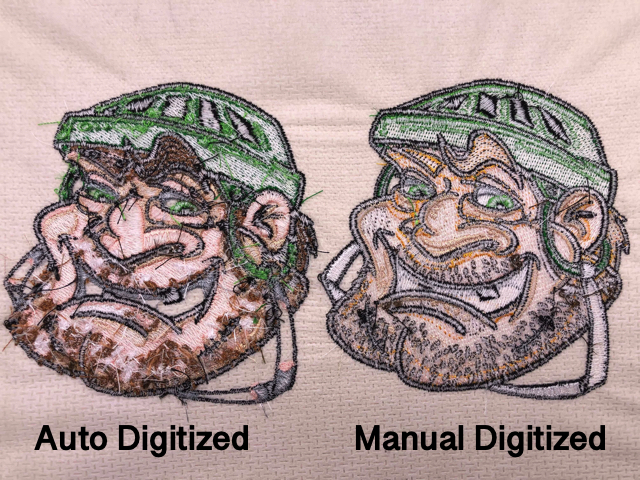Professional Digitizing for Embroidery: High-Quality Designs
Streamlining the Art of Needlework Digitizing: Step-by-Step Overview
As innovation continues to development, the digitization process has come to be extra easily accessible, permitting lovers to bring their intricate designs to life with convenience. In this overview, we will unwind the complexities of needlework digitizing, breaking down each step carefully to enhance the process and encourage both newbies and experienced embroiderers alike.
Comprehending Needlework Digitizing Software Program
Embroidery digitizing software works as an important tool for changing detailed styles right into digital formats suitable with embroidery equipments, assisting in precise sewing and personalization. This specialized software application allows customers to import numerous picture file layouts, such as JPG or PNG, and transform them right into embroidery machine-readable layouts like DST, EXP, or PES - Digitizing for Embroidery. By using features like stitch editing and enhancing, rug alternatives, and thread shade option, digitizing software application enables individuals to manage every facet of the layout procedure
Moreover, advanced embroidery digitizing software application provides tools for producing intricate styles, readjusting stitch thickness, and incorporating intricate details. Individuals can likewise sneak peek the style prior to sewing it out, ensuring accuracy and decreasing errors. Additionally, lots of software application supply automated features that assist streamline the digitizing process, conserving effort and time.
Comprehending the capabilities of embroidery digitizing software application is important for attaining high-quality cause embroidery tasks. By mastering this tool, embroidery lovers and experts can release their imagination and bring complex styles to life with precision and effectiveness.

Picking the Right Layout File
After familiarizing yourself with the capabilities of embroidery digitizing software, the next crucial action in the process is choosing the ideal layout apply for your job. Digitizing for Embroidery. When selecting a style declare needlework digitizing, it's important to consider the complexity of the design, the size of the final item, and the kind of material you will be functioning with
For detailed layouts with fine details, a high-resolution photo or vector data is suggested to ensure that the needlework maker can precisely recreate the design. Additionally, the dimension of the last item plays a substantial duty in picking the appropriate style documents. Larger designs may call for higher resolution files to maintain clarity and intensity.
Moreover, the sort of textile you will certainly be embroidering on affects the option of design data. Various materials might require modifications in the layout file to make sure that the stitches are properly lined up and the layout looks like meant. By thoroughly choosing the right style data based upon these aspects, you can establish on your own up for an effective embroidery digitizing process.
Digitizing Devices and Techniques
Making use of specialized software application and accuracy strategies, digitizing tools are crucial in changing detailed designs into embroidery-ready documents. Needlework digitizing software application, such as Wilcom, Hatch, or Embrilliance, provides the needed system to transform art work into stitch information. These programs supply features like stitch modifying, rug options, and lettering tools to make certain the design equates flawlessly onto fabric.
One of the vital methods in digitizing is developing a clear path for the embroidery maker to adhere to. This involves digitizing each visit this web-site component of the style with precision, establishing stitch kinds, densities, and instructions. By utilizing tools like digitizing tablets or software-specific plugins, embroiderers can accomplish a high level of precision in their digitized layouts.
In addition, mastering the art of underlay stitching is vital for generating top quality needlework. Underlay sewing stabilizes the fabric and creates a foundation for the design, guaranteeing that the end product is both visually appealing and long-lasting. By recognizing these digitizing devices and strategies, embroiderers can boost their craft and bring complex designs to life with precision and performance.
Customizing Stitch Kinds and Instructions
The selection of stitch kinds can considerably influence the general appearance and appearance of the embroidered layout. By tactically integrating these stitch kinds, embroiderers can attain depth and measurement in their styles.
Additionally, the direction of stitches plays an essential duty in boosting the visual appeal of the last embroidery. Varying stitch directions can add websites appearance, emphasize certain components, and develop aesthetic interest. Altering the angle of stitches can imitate motion or natural patterns like fur or feathers. By try out various stitch angles and patterns, embroiderers can bring their styles to life with remarkable information and intricacy. Understanding the art of personalizing stitch kinds and instructions equips embroiderers to unleash their creative thinking and raise the quality of their job.
Screening and Refining Your Digitized Design
To ensure the precision and quality of your digitized layout, comprehensive testing and refinement are vital action in the needlework digitizing process. When you have finished the digitization of your style, it is important to evaluate it prior to proceeding with the actual embroidery. Testing enables you to recognize any potential problems such as thread breaks, sew density issues, or design distortions that might influence the final outcome.

After screening, it is necessary to improve your digitized design based on the responses from the test sew-out. This may involve tweaking stitch settings, readjusting densities, or making adjustments to the overall layout to achieve the preferred end result. By iterating via visit this site testing and improvement, you can adjust your digitized design to perfection prior to progressing with the real embroidery process.
Verdict
Finally, mastering the art of embroidery digitizing calls for a comprehensive understanding of the software application, picking the appropriate style file, utilizing digitizing devices and techniques, personalizing stitch types and instructions, and testing and improving the digitized design. By complying with these steps, embroiderers can streamline the digitizing procedure and create premium embroidered layouts with precision and efficiency.